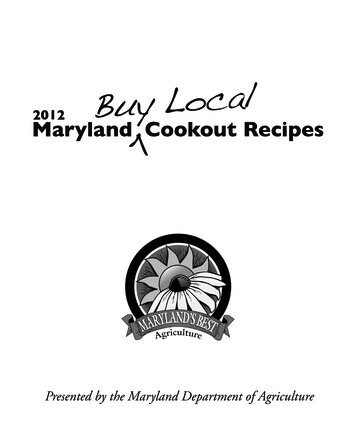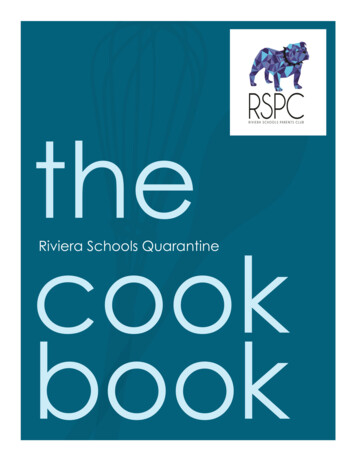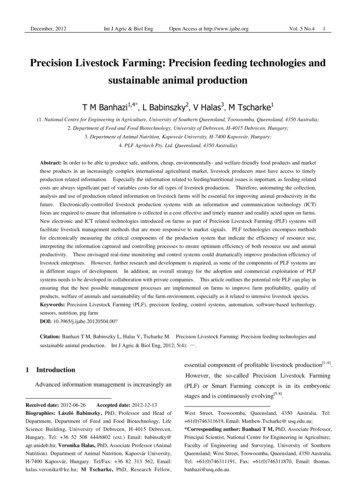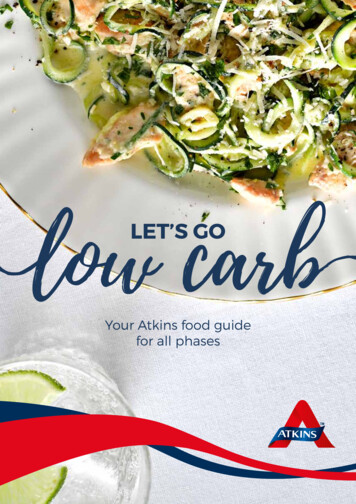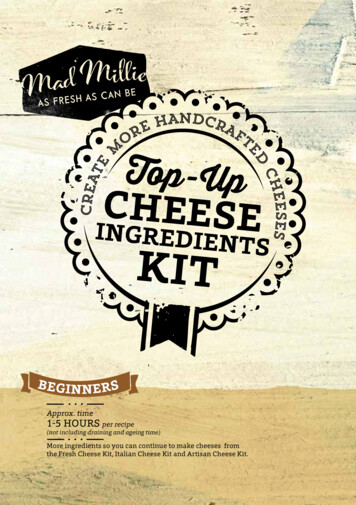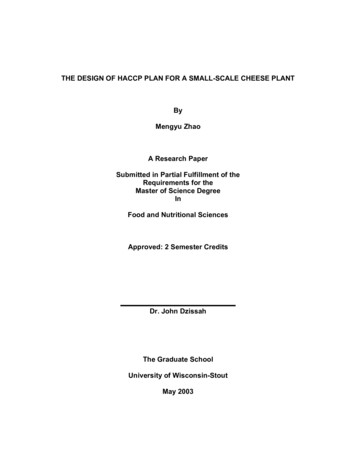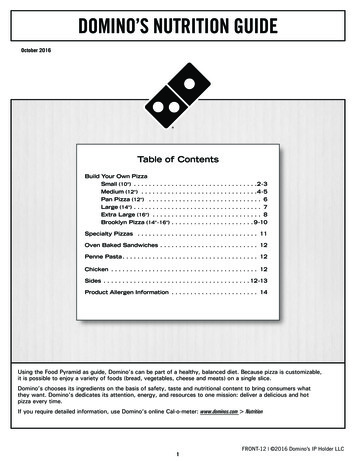
Transcription
contentsprefaceintroduction***peach mango cobblerchocolate ricottapoached pear with raspberriesmixed berry puddingtuscan strawberry meringuelemon cheesecakemixed nut cookieslemon blueberry biteschocolate hazelnut bitesraspberry peach granolapeanut butter cookiescheese blintzesapricot yogurt parfaitapple cinnamon tortilla cupschocolate cheesecake***about john berardiabout jason grenci***
prefaceby dr. john m. berardiWhen I first started out writing about nutrition, I have to admit that I don’t think I everenvisioned writing a dessert book.But a few months ago my good friend and excellent photographer, Jason Grenci,approached me with the idea while shooting the photos for a new cookbook we’ve beenworking on. And it wasn’t just an idea – he had the recipe ideas, the photo concepts, theworks. So we got down to business, and the result was this book you’re now reading,Gourmet Nutrition Desserts.In fact, I loved the book so much that I ultimately decided to make it freely available toall. What better way to promote our Gourmet Nutrition cookbook and the PrecisionNutrition system than to show people that healthy, high-performance eating can tastethis good?So I’d like to first thank Jason for making this happen, and I’d also like to thank mygood friend Dr. John K. Williams for the inspiration.About two years ago now, John and I sat down and wrote a book called GourmetNutrition.We were getting pretty tired of people saying that healthy food tastes like crap, or that itlacks “variety.” And we were getting even more tired of seeing people use that as anexcuse to eat poorly or to justify a lifestyle that even they knew was unhealthy.See, the whole “healthy food tastes bad” excuse is just lame.Having worked with thousands of clients around the world as a professional nutritionconsultant for over 10 years now, everyone from Olympic athletes to cardiac patients,from people just looking to eat healthy to those looking to make huge changes to theirbodies, I’ve pretty much seen it all. And I can tell you that there is some truth to thecliché: some “health food” is just plain awful, and a lot of it is not healthy at all. Andwhat’s worse is that people are content to eat it, mostly because they don’t think there’san alternative.
But I can also tell you that there are many people who eat healthy meals every day –either to feel better, or look better, or get strong enough and fast enough to reach theedge of human performance – and they do it by eating delicious meals and great tastingfood.Every day, there are people out there eating healthy, easy-to-make meals that could befound in gourmet restaurants. Meals that could impress the most discerning foodie.Meals that could fool a first date, or a reluctant spouse, or picky-eating kids. Meals thatjust plain taste good.Meals that, when planned and eaten consistently, can improve and even completelytransform your body.And how do they do it? With Gourmet Nutrition.Look, we’ve been there. We’ve eaten all that terrible food too. But at a certain point, itgets tiresome. It gets old.So we sat down and wrote Gourmet Nutrition, originally as an e-book, much like thePDF you’re reading right now. We came up with over 100 meals, from quick delicioussnacks right up to five-star sit-down feasts, and everything in between. We addedgeneral cooking instructions, helpful food facts, tips on grocery shopping, stocking yourkitchen and preparing meals for a hectic, on-the-go lifestyle.And people loved it. We got great feedback on it, except for one thing: people wanted itas a hardcopy, as an in-the-flesh book they could hold in their hands and lay flat on theircounters while they cooked.Fair enough. We not only did that, we went a step further.Rather than just giving everyone the recipe book, we wrote out the entire nutritionsystem we use with clients to go with it, to show you how to build those meals into acomplete plan that will deliver the results you want.Because, if you’re reading this, you’re probably not just eating for the heck of it. You’retrying to achieve something. You’re trying to change your body to work the way youwant it to work, to feel the way you want it to feel, to look the way you want it to look.
And to change your body, you need a plan.That’s where Precision Nutrition comes in. It’s a complete nutrition system coveringabsolutely everything you need to know. It includes a Gourmet Nutrition cookbook,printed and bound, and delivered right to your doorstep.It also includes membership to our private support site, where you have access tohundreds of user-submitted recipes, support from our coaches and thousands of membersworldwide, and online resources like results tracking software, goal-specific exerciseprograms designed by the top coaches in the world, and many more member exclusivesjust like this Gourmet Nutrition Desserts book you’re reading right now.I hope you enjoy these great Gourmet Nutrition desserts. And if you want more mealswhere these came from, along with a plan to put it all into action, find out more aboutPrecision Nutrition.All the best,John M. Berardi, PhD, CSCSPresident, Precision Nutritionwww.precisionnutrition.com
introductionI’m going to level with you here. I love dessert. And if I had to guess, I’d say that youdo too. The clue is that you’re reading this book right now.What I don’t love, though, is that guilty feeling I get right before ordering a dessert froma restaurant or pulling one out of the freezer.Or the guilty feeling I get while eating that dessert.Or the guilty feeling I get when I’m done.And before you call my emotional makeup into question, let’s face it: there’s reason tofeel guilty. Eat the standard sugar-laden, “bad fat” desserts every night for a few weeksand look in the mirror. That’s the reason.But that’s only one way to fit desserts into your diet.the three ways to include desserts in your diet1. Eat standard desserts, in any amount, at any time.This is the standard approach, eating dessert on a whim. See a cake in a bakery, or apastry on a serving tray, or chocolate ice cream in the fridge, and eat it, pure and simple,giving no thought as to how it fits into the plan. And most likely, there is no plan. Call itinstinctive eating, if-it-feels-good-do-it, whatever you want. The bottom line is that ifyou care about how you look – and it’s okay to care, you’re among friends here – this isthe worst possible way to go about it. People who do this, and again, we’ve all beenthere, are bound to make poor food choices, overeat, and in all likelihood gain fat.2. Eat standard desserts in strictly limited amounts at planned times.This is the “cheat meal” approach, and it’s definitely better than option #1. Hey,everyone has a favorite dessert. Mine is oatmeal chocolate chip cookies. Maybe yours issimple like cookie dough ice cream, or fancy like crème brûlée. And we want to eat thosefavorites without compromising on ingredients, the way your favorite restaurant makesit, or the way Grandma used to. And I’m cool with that. I have a couple of select mealsthat I’ll set aside time for, food you definitely won’t find in any health food store, and I’ll
make extra effort to compensate for them by making sure that I exercise a little more or alittle harder and that the rest of my diet is spot on (Precision Nutrition helps here).But we all know the problem with this method: the never-ending cheat meal. Somehowthat cheat meal turns into a cheat day, and the cheat day turns into a cheat week, andpretty soon you’re back to option #1 again, the cheat life. So while there’s a place forthis method, you have to honestly assess whether you’re the type who can handle it, orwhether you’re likely to go off the rails.Think back: were you the type who could smoke one cigarette every now and againwithout getting addicted – or did you have to either abstain completely or smokeanother? Can you have one beer or glass of wine while those around you have twelve –or do you have to either drink water or join the festivities? I won’t go into all the variousvices, because I’m sure you get the picture. Those same pressures, both internal andexternal, will face you every day when it comes to nutrition too. If you’re able to dabble,or “smoke without inhaling,” so to speak, then the cheat meal method may work foryou. But if you’re the all-or-nothing type, it’s better to choose “nothing” over “all” –best to accept your lot in life and leave the cheating to others. And if you’re not sure, askyour friends and family if they think you can handle it, or make the safe choice andassume that you can’t. In any case, I’ve got a better way.3. Turn standard desserts into Gourmet Nutrition Desserts, and fit them right intoyour regular nutrition plan.As you might have surmised, this is the preferred choice whenever possible. And it’spossible a lot more often than you think. With a little creativity and skill in the kitchen,most desserts can be modified to fit the principles outlined in Precision Nutrition. Theydon’t have to be your cheat meals, and they don’t have to add pounds to yourmidsection. In fact, they can even help you get in better shape than before.so what makes a gourmet nutrition dessert?Now, standard cheesecakes weighing in at 500 calories and 40g of fat per piece simplywon’t do. And 3 medium-sized cookies weighing in at 850 calories, 36g of fat, and 75gof sugar aren’t exactly physique friendly. These standard desserts are laden withcalories, and eating them regularly will almost certainly lead to a positive calorie balance(that’s a nice way of saying overeating). They also inject large amounts of saturated fat,sugar, and highly processed empty calories into your daily meal plan. And obviously,
that’s not the way to a lean, healthy physique.So what makes for a healthy, body-conscious Gourmet Nutrition dessert? A couple ofthings:1. Contains protein. Most standard desserts have little or no protein in them, andprotein is building block of muscle. Even if you don’t want to build more muscle, youdefinitely want to preserve the muscle you have as much as possible in order to keepyour metabolism high. Generally speaking, you should have protein in every meal, andif they’re to fit right into the plan, desserts should be no different. In practice, this oftenmeans adding commercial protein powder to desserts, so a quick note on proteinpowder: all are not created equal. Stay away from standard whey protein (dries out therecipes and tastes like sawdust), and look instead for a milk-protein blend. There are afew good ones out there, and a knowledgeable supplement store employee can help youchoose (or maybe not). We like Metabolic Drive by Biotest.2. Sugar-free. Sugar is not always the demon ingredient it’s made out to be (really, nosingle ingredient is absolutely good or absolutely bad – it depends on the whole diet), butthere are valid and strong reasons to limit it in your diet, and if possible remove itentirely. A sweetener like Splenda, though potentially not without it’s own drawbacks,can be used in small amounts to sweeten foods; even better is to add naturally sweetfruits.3. Healthy fats over bad fats. Whenever possible, to goal is to limit trans and excessivesaturated fats in favor of mono and polyunsaturates, and to include omega-3 fatty acidsas well.4. Limited calories. One of the major problems with standard desserts is that they’resimply too high in calories. Desserts in general tend to be very calorie-dense, meaningthat even small portions can have tons of calories. The key then is to reduce the caloricdensity if possible, and limit the total serving size so that you’re not sneaking hundredsof extra calories into your diet with each dessert.5. Fresh, natural, additive-free ingredients wherever possible. This one is less rigidlydefined, but in general the fresher the ingredient, the better. And ask yourself if you’veever seen what you’re about to eat growing in the ground or running around on a farmsomewhere. If the answer is no, you’re probably better off not eating it or limiting the
quantity. Ditto for anything that comes in a box or plastic container, or anything thatrequires colorful packaging or a huge advertising campaign to sell it. Now, understandthat these are just general rules, and while they often prove true, there’s no need to getzealous about it. There will be exceptions (using things like Splenda and proteinpowder), and dessert might just be where you make those exceptions. If so, make surethe rest of your diet draws almost exclusively on fresh, whole foods.6. Carbs only if you deserve them. The whole low-carb/high-carb debate is a littlemisunderstood in my opinion. The rule is basically this: carbs only if you deserve them.Meaning, have you been exercising? And how much? Because generally speaking, yourcarb intake should be proportionate to how hard and how much you exercise. That’swhy you see endurance athletes, who train for hours a day, eating huge 8,000 caloriediets containing extraordinary amounts of carbohydrate, all while maintaining a highperformance physique with virtually no body fat. Take someone with a sedentary officejob and give them the same diet, and they’ll be on the fast track to obesity. But put thatperson on a lower calorie, lower carbohydrate diet and they’ll make much betterprogress. And there are plenty of shades of grey in between. So again, the general rule isthe more and harder the exercise, the higher the total caloric intake and the higher thepercentage of carbohydrate in the diet. So when it comes to desserts, if you’reexercising, don’t be afraid to consume some carbs (but do put a limit on it, and domeasure how it affects your body composition). If you’re not exercising or exercisingvery little, you’ll do much better with fewer carbs. But then the question remains: whyaren’t you exercising more?7. Carbs only after workouts. In short, the research shows that the body toleratescarbohydrate very well immediately after exercise. So it’s a good idea to consume yourcarbs during the post-workout period. Again, this is a rule of thumb, because somepeople are able to tolerate carbohydrates quite well outside of this period too. Generally,though, those people know who they are – they’re naturally very lean, and often veryskinny. If you’re not one of those, then you’re best off consuming carbs only in the twoto three hours after an intense workout, or at least using that as the starting point forsome trial and error, slowly introducing carbs outside that window and measuring theresults.So what if you haven’t been exercising? Easy – cut the carbs. And what if you want thecarbs? Easy – exercise first. Following this general rule makes it pretty straightforwardto figure out how much carbohydrate you can include in your diet. That’s why I classifymeals as either post-workout (meals containing moderate to high carbohydrate, and to be
eaten in that two to three hour post-workout period) or any time (low-carb meals, to beeaten whenever you like).post-workout vs. any time mealsYou’ll notice, then, that all the meals in this book, and all the meals in the cookbookcontained in Precision Nutrition, are designated as either post-workout or any time meals.The designation is listed right under the title of the recipe, so you’ll be able to tell at aglance what type of meal it is. Remember, post-workout meals are for the two to threehours after intense exercise, while any time meals are for, well, any time. Want more ofthe carb-containing post-workout desserts? Well, drag your butt to the gym!now go forth and eatI hope you enjoy the Gourmet Nutrition Dessert meals as much as we enjoyed makingthem. If you want to submit your own recipes, post them in the Gourmet NutritionForum (members only) or email them to us at info@precisionnutrition.com. And if youwant more Gourmet Nutrition recipes in a hardcopy book that you can lay out on yourcounter while you cook, get yourself a copy of Precision Nutrition.
peach mango cobblerpost-workout 45 minutes1 cup whole wheat pancake mix4 scoops vanilla protein powder1 tbsp fresh, shredded, orange peel3 whole peaches, peeled and sliced1 mango, peeled and sliced1 cup water½ cup Splenda2 tsp cornstarchPreheat oven to 375 F. In a mixing bowl, prepare the wholewheat pancake mix following the instructions provided on thebox, making sure to use water instead of milk in yourpreparation process. Once the mixture is complete, take 4scoops of protein powder and mix into the whole wheatpancake mixture, one scoop at a time, ensuring that themixture remains slightly watery and not too thick. If themixture does thicken up too much, simply add small portionsof water while stirring in the protein powder to maintain theconsistency. When the protein powder has been folded in, add1tbsp fresh orange peel and mix it throughout.On a cutting board, peel and slice mango and peaches intowedges. In a saucepan, mix fruit wedges with 1 cup of waterand ½ cup of Splenda. Heat saucepan on medium-high heat,allowing water to come to a slight boil. After the water beginsto boil, remove 3 tablespoons of water from the saucepan andplace into a small bowl. In bowl, dissolve 2 tsp of cornstarchthoroughly in the water, then place back into the saucepan.Once the mixture turns thick in consistency (usually about aminute or two), turn off the burner and remove the saucepan.Pour the fruit mixture inside an 8-inch oven dish, and pour thepancake mix on top of the fruit. Place oven dish in the ovenand bake for roughly 20 minutes at 375 F, or until pancaketopping begins to crack. Remove from oven. Allow to cool forseveral hours on countertop or overnight in the fridge. Servecool.Makes 4 servings.NUTRITION INFORMATION(per serving)Calories334 kcalProtein26 gCarbohydrateFat44 g6gSaturated1.6 gMonounsaturatedPolyunsaturated2.1 g2.0 g
chocolate ricottaany time 120 minutes500 g light ricotta with wheycheese5 tbsp natural organic peanut butter4 scoops chocolate protein powder3 tbsp extra virgin olive oilPreheat oven to 300 F. In a mixing bowl, combine ricottacheese, natural peanut butter, protein powder and oil. Mixwell. Once mixed, scoop out 4 equal portions (an ice creamscooper helps here), placing each portion into a slot in a 12-slotmuffin tin. For smaller servings, divide into 8 equal portionsinstead.Bake in oven for 30 minutes. Remove from oven, and allow tocool on a rack. Serve once cool to the touch, or allow store inthe fridge overnight.Makes 4 servings.NUTRITION INFORMATION(per serving)Calories411 kcalProtein32 gCarbohydrateFat10 g27 gSaturated5.5 gMonounsaturatedPolyunsaturated8.8 g3.5 g
poached pear with raspberriespost-workout 60 minutes2 large Bosc pears5 cups water3 large slices lemon or orange peel2 sticks cinnamon2 scoops vanilla or strawberryprotein powder1 cup fresh raspberries2 tbsp SplendaOn a cutting board, peel 2 large Bosc pears. In a large pot onhigh heat, boil enough water to submerge the pears (usuallyabout 5 cups). Once the water is boiling, add the pears, thecinnamon, and 3 large slices of orange or lemon peel. Reduceheat to low-medium and allow to simmer.In a separate bowl, mix 2 scoops of protein powder and ½ cupof water until the mixture becomes pasty. Slowly add 1 cup ofraspberries, mashing the berries with a fork or potato masher.The mixture should form a liquid paste; if too thick and solid,add water 1 tbsp at a time to create a more fluid consistency.Add Splenda.Once your raspberry filling is finished, check on the pears.They are ready when a fork can be easily inserted into the flesh(usually 20-25 minutes). Once the pears are ready, removefrom the water and allow to cool. When cool to the touch, cuteach in half and remove the pit. Fill the centers of the pearswith the raspberry filling. Pour one tablespoon of the flavoredwater from the pot over the whole dessert.Makes 2 servings.NUTRITION INFORMATION(per serving)Calories356 kcalProtein25 gCarbohydrateFat54 g4.4 gSaturated0.6 gMonounsaturatedPolyunsaturated0.5 g2.3 g
mixed berry puddingpost-workout 30 minute prep, cool overnight1 cup water1 banana1 cup strawberries2 cups raspberries½ cup Splenda1 cup water4 scoops vanilla or strawberryprotein powder½ cup water3 tsp cornstarchIn a medium saucepan over medium heat, boil 1 cup of water.While the water is heating, cut banana, strawberries, andraspberries into pieces. Add the fruit pieces to the water fortwo minutes. After two minutes, leave the burner on andtransfer the water and fruit to a blender. Pulse the mixtureuntil all the fruit pieces have been blended. Pour contents backinto the saucepan, adding the Splenda and mixing. Allow themixture to again come to a boil.While the fruit mixture is heating, in a separate bowl mix 1/2cup of water and 3 tsp of cornstarch. Mix until all lumps areremoved. Once the fruit mixture begins to boil, pour the waterand cornstarch into the fruit. Allow to boil for one minuteuntil thick.Remove from the stove and place mixture into an 8-inch dish,or into four separate serving cups or ramekins. Allow to coolfor 10-15 minutes and place in the fridge for several hours.When done, the dessert will be jelly-like.Makes 4 servings.NUTRITION INFORMATION(per serving)Calories278 kcalProtein23 gCarbohydrateFat39 g3.3 gSaturated0.3 gMonounsaturatedPolyunsaturated1.0 g2.0 g
tuscan strawberry meringuepost-workout 45 minutes6 egg whites¼ tsp cream of tartar2 cups sliced strawberries2 tbsp Splenda4 scoops vanilla or strawberryprotein powderPreheat the oven to 250 F. In a large mixing bowl, beat 6 eggwhites and ¼ tsp of cream of tartar with an electric mixer onmedium-high speed, until the egg whites become fluffy andhold stiff peaks. Scoop this mixture out into two large ball-likeportions on a baking sheet lined with parchment paper. Withthe back of a large spoon, depress the middle of each portion toform a pocket (this is where the fruit will go). Bake in the ovenuntil the mixture turns light golden brown, between 5 and 10minutes. Remove from oven and set aside to let cool.Cut up 2 cups of strawberries and mix in a bowl with Splenda.Add the protein powder to this mixture, 1 scoop at a time,mixing well. Once these dry ingredients are mixed together,add water – 1 tbsp at a time – until the mixture becomescreamy.Next, pour the strawberry mixture into the meringue pockets,letting it flow over the sides. Serve cool.Makes 2 servings.NUTRITION INFORMATION(per serving)Calories330 kcalProtein52 gCarbohydrateFat20 g4.7 gSaturated1.0 gMonounsaturatedPolyunsaturated2.1 g1.6 g
lemon cheesecakeany time 60 minute prep, cool overnightCHEESECAKE250 g fat free cottage cheese2 omega-3 eggs¾ cup Splenda2 lemons, juiced½ tsp baking powderZest from half a lemonTOPPING½ cup strawberries½ cup water1 tsp SplendaPreheat oven to 375 F. In a blender, blend cottage cheese andeggs until smooth and creamy in texture. Remove mixturefrom blender and place into a mixing bowl. Mix in Splendaand lemon juice. Finally, add baking powder and lemon zestand mix well.Fill two 2 ½” ramekins with the mixture. Fill a large bakingpan half-full with hot water. Place the ramekins inside thebaking pan so that the water comes approximately half way upthe sides of ramekins. Place the baking pan containing theramekins into the oven and allow to bake for 35 to 40 minutes.When finished baking, remove the baking pan from the ovenand the ramekins from the water. Allow ramekins to cooloutside of the water pan. When cool to the touch, place intothe fridge over night.To make strawberry topping, blend strawberries, water andSplenda and drizzle over cheesecake.Makes 2 servings.NUTRITION INFORMATION(per serving)Calories324 kcalProtein57 gCarbohydrateFat8g7.1 gSaturated2.4 gMonounsaturatedPolyunsaturated3.4 g1.3 g
mixed nut cookiesany time 20 minutes3 tsp Olivina (non-hydrogenatedolive oil margarine)Preheat oven to 375 F. In a mixing bowl, mix Olivina,Splenda, omega-3 egg and ground cinnamon.NUTRITION INFORMATION1 cup SplendaNext, add crushed pecans, peanuts and walnuts to the bowl.Finally, add 3 scoops of protein powder and mix well.Calories1 omega-3 egg1½ tsp ground cinnamon2/3 cup pecans, crushed2/3 cup peanuts, crushed2/3 cup walnuts, crushed3 scoops vanilla or chocolateprotein powderOn a baking sheet lined with parchment paper, scoop out 6equal portions of the mixture, separating them about 2 inchesapart from one another. Take a fork and gently press down onthem, flattening the mixture into cookies.Place into the oven for 6 minutes, or until you see the Olivinabubbling from the cookies. When finished, pull from the ovenand allow to cool on a wire rack, or on a plate. Serve warm orcool, or seal and store in fridge.Makes 6 servings.(per serving)396 kcalProtein19 gCarbohydrateFat8g32 gSaturatedMonounsaturatedPolyunsaturated3.5 g12.9 g15.6 g
lemon blueberry bitesany time 80 minute prep, cool overnightBITES6 egg whites1 omega-3 egg4 scoops vanilla protein powder2 tbsp vanilla extract250 g light ricotta with wheycheese½ cup SplendaZest from one lemon½ cup blueberriesTOPPING½ cup blueberries½ cup water1 tsp SplendaPreheat oven to 350 F. Combine egg whites and omega-3 eggin a bowl and whisk. Add protein powder, one scoop at atime, mixing throughout. Place this mixture into a blenderand blend on medium speed to create smoother consistency.Add vanilla and continue blending for 10 seconds.Next, mix 250 g ricotta cheese and Splenda in a bowl. Then,take the egg-protein mixture and pour into the ricotta mixture,mixing together. Add the zest from lemon and the blueberries,and mix all together.Pour the entire mixture into a large ramekin, 6” in diameter.Fill a deep baking pan half-full with hot water and place theramekin inside of the oven pan so that the water comesapproximately half way up the outside of the ramekincontaining the berry and ricotta mixture. Place the baking pancontaining the ramekin into the oven and bake forapproximately 1 hour, or until slightly firm to the touch. Oncefinished, take out of the oven and place the ramekin onto awire rack to cool. When cool to the touch, place in the fridgeover night.To make blueberry topping, blend blueberries, water andSplenda.To serve, use a cookie cutter to cut circular shapes out of themixture in the ramekin, and drizzle blueberry topping over top.Makes 4 servings.NUTRITION INFORMATION(per serving)Calories439 kcalProtein33 gCarbohydrateFat7g31 gSaturatedMonounsaturatedPolyunsaturated8.1 g12.1 g11.1 g
chocolate hazelnut bitesany time 80 minute prep, cool overnight2/3 cup hazelnuts, roasted4 omega-3 eggs¾ cup Splenda1 tsp espresso coffee powder5 scoops chocolate protein powder2/3 cup pecan meal2/3 cup crushed walnuts2/3 cup unsalted peanuts, crushedPreheat oven to 350 F. On a baking sheet, spread hazelnutsand roast them in the oven for 6 to 8 minutes. When finished,pull hazelnuts out of the oven and place onto a towel. Put 8 ofthe hazelnuts aside for later. Next, use the towel to rub theskin off all but the 8 hazelnuts you put aside.With an electric mixer, mix together the omega-3 eggs,Splenda, and espresso coffee powder. Next, add proteinpowder, one scoop at a time, mixing thoroughly. Finally, addthe de-skinned hazelnuts (leaving the 8 full hazelnuts aside),pecan meal, crushed walnuts and peanuts. Mix well. Themixture should become thick and dough like.With wet hands, separate the mixture into 8 equal portions.For each portion, place one of the 8 hazelnuts set aside earlierinto the center of the portion, rolling the portion into a smallround shape until it completely covers the hazelnut in thecenter. Place each bite-sized shape onto a baking sheet linedwith parchment paper. Place the sheet into the oven for 10minutes. When complete, pull from the oven and allow tocool. These can be eaten warm, or stored in an air-tightcontainer in the fridge and served cool later.Makes 8 servings.NUTRITION INFORMATION(per serving)Calories394 kcalProtein22 gCarbohydrateFat9g30 gSaturatedMonounsaturatedPolyunsaturated3.1 g15.8 g11.2 g
raspberry peach granolapost-workout 2 ½ hours2 cups whole oats4 scoops vanilla or strawberryprotein powder4 tbsp honey4 tbsp light maple syrup1 cup fresh raspberries4 small peaches, peeled and slicedPreheat oven to 275 F. To make the granola, combine wholeoats, protein powder, honey and light maple syrup in a smallbowl. Mix well.On a baking sheet lined with parchment paper, pour themixture out and flatten. Place into the oven and bake untilgolden brown, usually around 40 to 45 minutes, checking oftento ensure the oats don’t burn. When done, remove bakingsheet from oven and allow to cool until granola is hard andcool to the touch.In a blender, blend the granola in pulse mode, just enough tobreak up the big pieces but not so much as to grind it into apowder. Place granola pieces into a small bowl and set aside.In the blender, blend raspberries until a watery consistency isachieved. Next, on a cutting board, peel and slice 4 smallpeaches and divide evenly into 4 separate bowls. Over the topof the peaches, sprinkle even amounts of granola in each bowl.Mix together. Finally, top everything off with the raspberrypuree and mix well.Makes 4 servings.NUTRITION INFORMATION(per serving)Calories415 kcalProtein25 gCarbohydrateFat72 g3gSaturated0.6 gMonounsaturatedPolyunsaturated1.2 g0.8 g
peanut butter cookiesany time 45 minutes1 cup organic peanut butter2 omega-3 eggs½ cup unsalted peanuts, crushed5 scoops chocolate or vanillaprotein powderPreheat oven to 350 F. In a mixing bowl, add the organicpeanut butter and omega-3 eggs and mix well. Add crushedunsalted peanuts. Now, one scoop at a time, add 5 scoops ofprotein powder, mixing in thoroughly. The mixture will beginto get dry, so add 3 tbsp olive oil, 1 tbsp at a time, to moisten.¾ cup SplendaOn a baking sheet, form 6 equal portions and flatten with afork to form a cookie. Place into the oven and bake for a totaltime of 20 minutes. When done the cookies should feelslightly firm and dry to the touch.3 t
hundreds of user-submitted recipes, support from our coaches and thousands of members worldwide, and online resources like results tracking software, goal-specific exercise programs designed by the top coaches in the world, and many more member exclusives just like this Gourmet Nutrition Desserts book you're reading right now.
